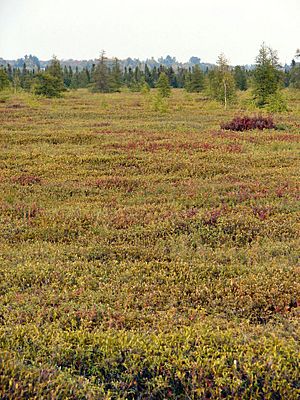Bog facts for kids
A bog is a special type of wetland where a lot of dead plant material builds up. This material is called peat. Most of the time, this peat is made of dead mosses, especially a type called Sphagnum moss. Bogs are one of the four main kinds of wetlands. You might also hear them called mires or muskegs.
Bogs often have special shrubs growing in them, rooted in the Sphagnum moss and peat. As dead plants pile up, bogs become a "carbon sink". This means they store a lot of carbon, which helps keep it out of the air.
The water in bogs is usually acidic and doesn't have many nutrients. Sometimes, bogs get all their water from rain and snow. The water that flows out of bogs often looks brown. This color comes from natural chemicals called tannins from the peat.
Plants grow slowly in bogs because the climate is cool and there aren't many nutrients. But dead plants decay even slower because the soil is always wet. This is why peat builds up over many years, sometimes several meters deep! Bogs are home to unique plants and animals. They are very important for biodiversity, especially in areas where most land is used for farming or cities.
Contents
Where Are Bogs Found?
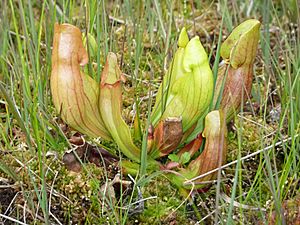
Bogs are found all over the world in cold and temperate areas, especially in the Northern Hemisphere. The biggest wetland in the world is the peat bogs in the Western Siberian Lowlands in Russia. They cover more than a million square kilometers!
North America also has huge peat bogs, like those in the Hudson Bay Lowlands in Canada. Bogs are less common in the Southern Hemisphere. The largest one there is the Magellanic moorland in South America. Many Sphagnum bogs used to be common in northern Europe, but many have been drained for farming. Recent studies show that many European peatlands have become much drier because of human activities like draining, cutting peat, and burning.
In 2014, explorers found a huge peat bog in the Republic of the Congo that is "as big as England"! It also stretches into the Democratic Republic of the Congo.
What Makes a Bog a Bog?
It can be tricky to define bogs perfectly because they can be different from place to place. However, all bogs share some key features:
- They have peat, usually more than 30 centimeters (about 1 foot) thick.
- They get most of their water and nutrients from rain and snow, not from rivers or groundwater.
- They don't have many nutrients.
- They are very acidic. (Bogs near the coast might be a little less acidic due to sea spray.)
Since all bogs have peat, they are a type of peatland. Bogs are different from "fens," which are another type of wetland. Fens get their water and nutrients from mineral-rich groundwater, so they are usually less acidic. Bogs, on the other hand, are always acidic because rainwater doesn't have many minerals.
Animals and Plants of the Bog
Bogs are home to many special animals, fungi, and plants. Most of them can handle the low nutrient levels and the very wet conditions. Sphagnum moss is usually very common, along with evergreen shrubs. These shrubs may keep their leaves to help save nutrients. In drier parts of a bog, evergreen trees might grow, making the bog blend into the surrounding forest.
Sedges are common grassy plants in bogs. Some amazing plants, like carnivorous plants such as sundews (Drosera) and pitcher plants (like Sarracenia purpurea), have adapted to the low-nutrient conditions. They catch and eat invertebrates (like insects) to get the nutrients they need! Orchids also live in bogs and get nutrients with the help of special fungi. Some shrubs, like Myrica gale (bog myrtle), have special bumps on their roots that help them get nitrogen from the air.
Bogs are important habitats for many animals. They can be home to large mammals like caribou, moose, and beavers. Many birds, like Siberian cranes and greater yellowlegs, nest in bogs. Some bogs even have rare reptiles, such as the bog turtle. Unique insects also live in bogs, like the hairy canary fly in English bogs or the bog copper butterfly in North America. In Ireland, the viviparous lizard, the only reptile in the country, lives in boglands.
Many countries recognize bogs as important habitats that need protection. For example, the United Kingdom has made bog habitats a top priority for conservation. Russia also has large protected areas for bogs in the West Siberian Lowland.
Types of Bogs
Bogs can form in different ways depending on the climate and the shape of the land.
Valley Bogs
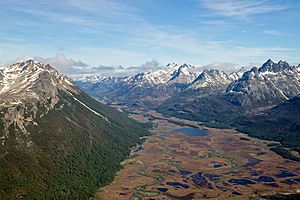
These bogs grow in gently sloping valleys or dips in the land. A layer of peat fills the lowest part of the valley, and sometimes a stream flows through the bog's surface. Valley bogs can even form in drier, warmer places, but they need to be on acidic ground because they rely on water from the ground or surface.
Raised Bogs
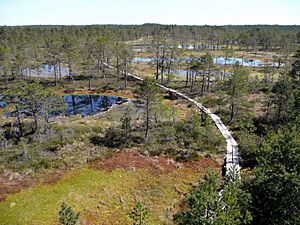
Raised bogs start in a lake or a flat, marshy area. Over hundreds of years, silt and peat build up in the lake, slowly turning it into a marsh, then a fen, and eventually a bog. The peat builds up so much that the center of the wetland becomes higher than the surrounding land. This raised part only gets water from rain, making it very acidic. This allows the bog to grow into a dome shape, often several meters high in the middle. The edges of the raised bog might still have fen or other wet plants where groundwater can reach.
Blanket Bogs
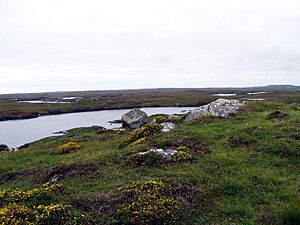
In cool places with lots of rain (more than 235 days a year), the ground stays wet for a long time. This creates perfect conditions for bogs to grow. In these areas, the bog forms a layer that "blankets" the land, even covering hilltops and slopes. While blanket bogs are more common on acidic ground, they can sometimes form on neutral or even alkaline ground if there's enough acidic rainwater. In Europe, these bogs with thin peat layers cover hills and valleys in Ireland, Scotland, England, and Norway. In North America, blanket bogs are mostly found in Canada, east of Hudson Bay.
Quaking Bogs
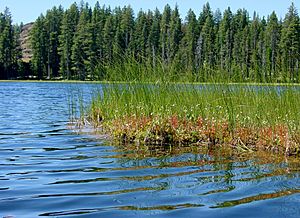
A quaking bog is a type of floating bog found in wetter parts of valley bogs and raised bogs, or around the edges of acidic lakes. The bog plants, mostly Sphagnum moss held together by sedges, form a floating mat about half a meter thick on top of the water or very wet peat. When you walk on it, the surface moves and shakes – it can even make trees sway! Over time, this mat can spread across bays or even cover small lakes. Sometimes, parts of the bog mat can break off and form floating islands.
How Bogs Are Used
Industrial Uses
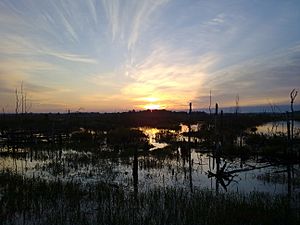
After it's dried, peat can be used as a fuel. People have used it for centuries to heat homes, especially in Ireland, Finland, Scotland, Germany, and Russia. Russia is the biggest exporter of peat for fuel. Ireland's Bord na Móna company was one of the first to harvest peat using machines, but they are now stopping this practice.
Another main use for dried peat is to improve garden soil. It's sold as "moss peat" or "sphagnum peat" and helps soil hold more moisture and nutrients. It's also used as a mulch. Some distilleries, especially those making Scotch whisky on the island of Islay, use smoke from peat fires to dry the barley used in their whisky.
Once peat is taken out, it's very hard to bring the wetland back, because peat builds up so slowly. More than 90% of bogs in England have been damaged or destroyed. In 2011, the UK government announced plans to stop using peat in gardening products.
Other Uses
The peat in bogs is very important for storing carbon. If the peat decays, it releases carbon dioxide into the air, which adds to global warming. When bogs are left alone, they act like a "carbon sink" and help fight climate change. For example, the peatlands in the former Soviet Union were estimated to remove 52 million tons of carbon from the air each year. So, restoring drained peatlands can be a very good way to help slow down climate change.
Peat bogs also help store fresh water, especially at the start of large rivers. Even the huge Yangtze River in China begins in the Ruoergai peatland in Tibet.
Many delicious berries grow wild in bogs, like blueberries, cranberries, cloudberries, and lingonberries. Sometimes, old wood that has been partly preserved by bogs, called bog oak, is used to make furniture.
Bogs are also great places for outdoor activities like ecotourism (visiting nature without harming it) and hunting. Many popular canoe routes in northern Canada go through peatland areas. However, some activities, like using all-terrain vehicles, can be very damaging to bogs.
Amazing Discoveries in Bogs
The special conditions in bogs, like the lack of oxygen and the presence of natural acids, can preserve organic materials in an amazing way. Many discoveries have been made in bogs in places like Slovenia, Denmark, Germany, Ireland, Russia, and the United Kingdom.
Some bogs have preserved bog-wood, like ancient oak logs, which are useful for studying tree rings and past climates. Even more incredible are the extremely well-preserved bog bodies found in bogs. These are human bodies from thousands of years ago, with their hair, organs, and skin still intact! They are thought to have been part of ancient Germanic and Celtic human sacrifice rituals. Famous examples include Haraldskær Woman and Tollund Man in Denmark, and Lindow man found in England.
At Céide Fields in County Mayo, Ireland, a 5,000-year-old neolithic (New Stone Age) farming area was found perfectly preserved under a blanket bog, complete with old field walls and hut sites. Another ancient item found in various bogs is bog butter, which are large amounts of fat, usually in wooden containers. People think these were food stores of both butter and tallow.
World's Largest Peat Bog
The world's largest peat bog is in the Republic of the Congo. It's as big as England! This huge bog covers between 100,000 and 200,000 square kilometers (40,000 to 80,000 square miles). The peat layer can be up to 7 meters (23 feet) deep. It holds billions of tons of partially decayed plants, making it a massive carbon store.
Images for kids
-
A bog in Lauhanvuori National Park, Isojoki, Finland.
-
Precipitation collects in many bogs, forming bog pools, like this one in Koitjärve bog in Estonia.
-
Sphagnum moss with northern pitcher plants at Brown's Lake Bog, Ohio.
-
A bog in Ostfriesland, Germany.
See also
 In Spanish: Turbera para niños
In Spanish: Turbera para niños


